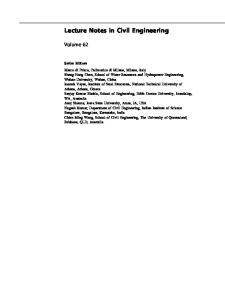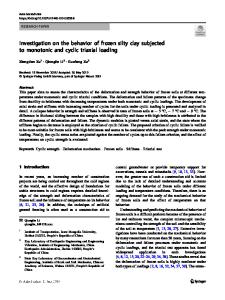Dynamic mechanical properties and mesostructure evolution of granular materials subjected to cyclic loading
- PDF / 10,453,581 Bytes
- 20 Pages / 595.276 x 790.866 pts Page_size
- 96 Downloads / 330 Views
ORIGINAL PAPER
Dynamic mechanical properties and mesostructure evolution of granular materials subjected to cyclic loading Yi Sun1 · Enlong Liu1,2 · Lian Jiang1 · Jianqiu Tian1 · Xiaoqiong Jiang1 · Ran Xu1 Received: 18 March 2019 © Springer-Verlag GmbH Germany, part of Springer Nature 2020
Abstract In this study, a series of biaxial undrained tests of granular materials subjected to cyclic loading were conducted using the discrete element method to investigate the mesostructure evolution from the perspective of a complex network. The mesoscopic parameters, including the average degree, clustering coefficient, and average shortest path length, were used to illustrate the mesostructure evolution of assemblies upon cyclic loading. The results showed that the macroproperties of granular materials have a close relationship with the mesostructure evolution. The amplitude of the axial strain and the pore-water pressure gradually increased with an increase in the number of cycles, whereas the average degree and clustering coefficient decreased. In addition, the amplitude of the average shortest path length varied more drastically. The mesomechanism for the process could be described as follows. In the sample, as the number of contacts and ability to transmit contact force both decreased, the contact network of the assembly became looser and the strength decreased. A larger amplitude for the axial stress led to quicker changes in the pore-water pressure, strain, and mesoscopic parameters. When the value of the normal contact force was regarded as a weight, it was found that the weighted average degree had an approximately linear positive correlation with the mean effective stress. The evolution of the deformation and pore-water pressure could be explored from the mesoscopic viewpoint using the mean weighted ratio of connected triads. Keywords Cyclic loading · Complex network · Granular materials · Mesostructure · Dynamic strength
1 Introduction The cyclic loads caused by an earthquake, blasting, traffic, and mechanical vibrations can deform or even damage the soil around a foundation, or on a slope or an embankment. In geotechnical engineering, sand composed of an assembly of soil particles without cohesion can be regarded as a granular material. Numerous loading and unloading cycles can decrease the strength and increase the pore-water pressure and deformation accumulation of soil, which may cause it to fail. This can result in a landslide, foundation instability, or other disasters (Toyota and Takada [35]; Wichtmann et al. * Enlong Liu [email protected] 1
State Key Laboratory of Hydraulics and Mountain River Engineering, College of Water Resources and Hydropower, Sichuan University, Chengdu 610065, China
State Key Laboratory of Frozen Soil Engineering, Northwest Institute of Eco‑Environment and Resources, Chinese Academy of Sciences, Lanzhou 730000, China
2
[40–42]). Although the mechanical properties and behaviours of sandy materials subjected to cyclic loading have been extensively studied macroscopical
Data Loading...










